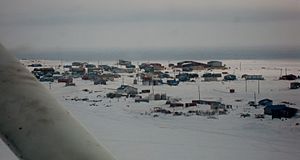Eek, Alaska facts for kids
Quick facts for kids
Eek
Ekvicuaq
|
|
|---|---|

Eek, Alaska, from a bush plane
|
|
| Country | |
| State | |
| Census Area | Bethel |
| Incorporated | July 9, 1970 |
| Area | |
| • Total | 0.74 sq mi (1.92 km2) |
| • Land | 0.65 sq mi (1.68 km2) |
| • Water | 0.09 sq mi (0.24 km2) |
| Elevation | 3 ft (1 m) |
| Population
(2020)
|
|
| • Total | 404 |
| • Density | 623.46/sq mi (240.83/km2) |
| Time zone | UTC-9 (Alaska (AKST)) |
| • Summer (DST) | UTC-8 (AKDT) |
| ZIP codes |
99578
|
| Area code | 907 |
| FIPS code | 02-21040 |
| GNIS feature ID | 1401666 |
Eek (which is Iik in the Yupik language) is a small city in Bethel Census Area, Alaska, United States. In 2020, about 404 people lived there. Most of the people living in Eek are Alaska Natives.
Contents
What's in a Name?
The name Eek comes from a Yupik word that means "two eyes." It's sometimes mentioned as one of the more unusual place names.
Where is Eek?
Eek is located in Alaska at 60°13′7″N 162°1′33″W / 60.21861°N 162.02583°W. It sits right next to the Eek River.
The city covers about 0.74 square miles (1.92 square kilometers). Most of this area is land, with a small part being water.
How People Get Around and Live in Eek
Travel and Transportation
People in Eek mostly use the Eek Airport to travel. There's also an old airport runway nearby that some private planes still use.
A town dock lets people use the Eek River. This river connects to the Kuskokwim River, which means people can travel by boat to many nearby villages. In winter, when the rivers freeze, people use snow machines to get around. Trails connect Eek to villages like Quinhagak, Tuntutuliak, and the Bethel area.
Traveling to Bethel, the closest large town, can be quite expensive. This makes it harder for people to get medical care or visit government offices.
Daily Life Challenges
Houses in Eek don't have numbers. This can make it tricky for people to get official identification, like a driver's license.
Learning in Eek
Eek School
The Lower Kuskokwim School District runs the Eek School. This school teaches students from Pre-kindergarten all the way to 12th grade. It offers classes in two languages. In 2018, the school had 120 students and six teachers.
The school is getting a big upgrade! In 2020, the state gave $34.4 million to build a new school. This new building will help with the growing number of students and should be ready by 2022.
Local History and Art
Two teachers from the Eek School, Paul and Eloise Forrer, collected many photos of Eek and nearby villages. They also made a film called The Children of Eek and their art. Their work, mostly from the 1970s to 1990s, is now kept at the Anchorage Museum.
Eek's Population Over Time
| Historical population | |||
|---|---|---|---|
| Census | Pop. | %± | |
| 1920 | 119 | — | |
| 1930 | 100 | −16.0% | |
| 1940 | 170 | 70.0% | |
| 1950 | 141 | −17.1% | |
| 1960 | 200 | 41.8% | |
| 1970 | 186 | −7.0% | |
| 1980 | 228 | 22.6% | |
| 1990 | 254 | 11.4% | |
| 2000 | 280 | 10.2% | |
| 2010 | 296 | 5.7% | |
| 2020 | 404 | 36.5% | |
| U.S. Decennial Census | |||
The village of Eek wasn't always in the same spot. It used to be on the Apokak River. But in the late 1920s, people had to move because of floods and erosion.
In 1900, the village was called "Apokagamiut" and had 118 residents. By 1910, the number dropped to 68. Eek officially became a city in 1970.
In 2000, there were 280 people living in Eek. Most of them (about 95.7%) were Alaska Natives, mainly Yupik. In 2019, the population grew to 474 residents, with 98% being Yup'ik Natives.
Many families in Eek have children. The average age of people living in Eek in 2000 was 24 years old.
How People Make a Living
Most families in Eek rely on a traditional native subsistence lifestyle. This means they get their food and other needs directly from the land and water, like hunting, fishing, and gathering.
City Services and Modern Connections
Water System
Before 2019, Eek did not have running water in homes. Water was delivered by truck, and families had to pay for it. To improve health and living conditions, the Alaska Native Tribal Health Consortium helped the city get a grant. This money was used to build a system that brings piped running water to homes, which was finished in 2019.
Internet Access
Eek has only one main internet provider, General Communication Inc., besides satellite options.
See also
 In Spanish: Eek (Alaska) para niños
In Spanish: Eek (Alaska) para niños


